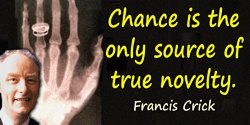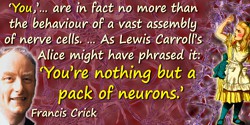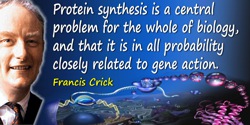 (source)
(source)
|
Francis Crick
(8 Jun 1916 - 28 Jul 2004)
English biochemist and biophysicist who shared the 1962 Nobel Prize for Physiology or Medicine establishing the double-helix molecular structure of DNA (deoxyribonucleic acid).
|
Francis Crick Quotes on Watson_James (10 quotes)
>> Click for 55 Science Quotes by Francis Crick
>> Click for Francis Crick Quotes on | DNA | Life | Molecular Biology | Structure Of DNA |
>> Click for 55 Science Quotes by Francis Crick
>> Click for Francis Crick Quotes on | DNA | Life | Molecular Biology | Structure Of DNA |
I argued that it was important not to place too much reliance on any single piece of experimental evidence. It might turn out to be misleading, as the 5.1 Å reflection undoubtedly was. Jim was a little more brash, stating that no good model ever accounted for all the facts, since some data was bound to be misleading if not plain wrong. A theory that did fit all the data would have been “carpentered” to do so and would thus be open to suspicion.
— Francis Crick
In What Mad Pursuit: A Personal View of Scientific Discovery (1988), 59-60.
If Watson and I had not discovered the [DNA] structure, instead of being revealed with a flourish it would have trickled out and that its impact would have been far less. For this sort of reason Stent had argued that a scientific discovery is more akin to a work of art than is generally admitted. Style, he argues, is as important as content. I am not completely convinced by this argument, at least in this case.
— Francis Crick
What Mad Pursuit (1990), 76.
If, for example, I had some idea, which, as it turned out would, say, be quite wrong, was going off of the tangent, Watson would tell me in no uncertain terms this was nonsense, and vice-versa. If he had some idea I didn’t like and I would say so and this would shake his thinking about it and draw him back again. And in fact, it’s one of the requirements for collaboration of this sort that you must be perfectly candid, one might almost say rude, to the person you are working with. It’s useless, working with somebody who’s either much too junior than yourself, or much too senior, because then politeness creeps in. And this is the end of all real collaboration in science.
— Francis Crick
As quoted in Robert Olby, The Path to the Double Helix: The Discovery of the Double Helix, (1974, 1994), 316, citing Transcript of BBC TV program, The Prizewinners (1962).
It has not escaped our notice that the specific pairing we have postulated immediately suggests a possible copying mechanism for the genetic material.
[Concluding remark in the paper by Watson and Crick announcing discovery of the structure of DNA.]
[Concluding remark in the paper by Watson and Crick announcing discovery of the structure of DNA.]
— Francis Crick
In J.D. Watson and F.H.C. Crick, 'A Structure for Deoxyribose Nucleic Acid,' Letter in Nature (25 Apr 1953), 171, 738. Quoted in Francis Crick, What Mad Pursuit (1990), 66.
It is one of the striking generalizations of biochemistry—which surprisingly is hardly ever mentioned in the biochemical text-books—that the twenty amino acids and the four bases, are, with minor reservations, the same throughout Nature. As far as I am aware the presently accepted set of twenty amino acids was first drawn up by Watson and myself in the summer of 1953 in response to a letter of Gamow's.
— Francis Crick
'On the Genetic Code', Nobel Lecture, 11 December 1962. In Nobel Lectures: Physiology or Medicine 1942-1962 (1964), 811.
Jim and I hit it off immediately, partly because our interests were astonishingly similar and partly, I suspect, because a certain youthful arrogance, a ruthlessness, an impatience with sloppy thinking can naturally to both of us.
— Francis Crick
In What Mad Pursuit (1990), 64.
Rather than believe that Watson and Crick made the DNA structure, I would rather stress that the structure made Watson and Crick.
— Francis Crick
In What Mad Pursuit: A Personal View of Scientific Discovery (1988), 76.
The major credit I think Jim and I deserve … is for selecting the right problem and sticking to it. It’s true that by blundering about we stumbled on gold, but the fact remains that we were looking for gold. Both of us had decided, quite independently of each other, that the central problem in molecular biology was the chemical structure of the gene. … We could not see what the answer was, but we considered it so important that we were determined to think about it long and hard, from any relevant point of view.
— Francis Crick
In What Mad Pursuit (1990), 74-75.
Watson and I had been often discussing the problem, the ways you could go wrong solving problems of this sort, the techniques you have to use, and in particular, such rather curious things as you mustn’t pay too much attention to the all the experimental evidence, some of it may be wrong, for example.
— Francis Crick
From Transcript of BBC TV program, The Prizewinners (1962).
We wish to suggest a structure for the salt of deoxyribose nucleic acid (DNA). This structure has novel features which are of considerable biological interest.
[Opening remark in the paper by Watson and Crick announcing discovery of the structure of DNA.]
[Opening remark in the paper by Watson and Crick announcing discovery of the structure of DNA.]
— Francis Crick
In J.D. Watson and F.H.C. Crick, 'A Structure for Deoxyribose Nucleic Acid,' Letter in Nature (25 Apr 1953), 171, 737. Quoted in Diane Dowdey, The Researching Reader: Source-based Writings Across the Disciplines (1990), 203.
See also:
- 8 Jun - short biography, births, deaths and events on date of Crick's birth.
- Francis Crick: Hunter of Life's Secrets, by Robert Olby. - book suggestion.
- Francis Crick: Discoverer of the Genetic Code, by Matt Ridley. - book suggestion.
- Astonishing Hypothesis: The Scientific Search for the Soul, by Francis Crick. - book suggestion.
- Of Molecules and Men, by Francis Crick. - book suggestion.
- Life Itself: Its Origin and Nature, by Francis Crick. - book suggestion.
- What Mad Pursuit: A Personal View of Scientific Discovery, by Francis Crick. - book suggestion.



 In science it often happens that scientists say, 'You know that's a really good argument; my position is mistaken,' and then they would actually change their minds and you never hear that old view from them again. They really do it. It doesn't happen as often as it should, because scientists are human and change is sometimes painful. But it happens every day. I cannot recall the last time something like that happened in politics or religion.
(1987) --
In science it often happens that scientists say, 'You know that's a really good argument; my position is mistaken,' and then they would actually change their minds and you never hear that old view from them again. They really do it. It doesn't happen as often as it should, because scientists are human and change is sometimes painful. But it happens every day. I cannot recall the last time something like that happened in politics or religion.
(1987) -- 


